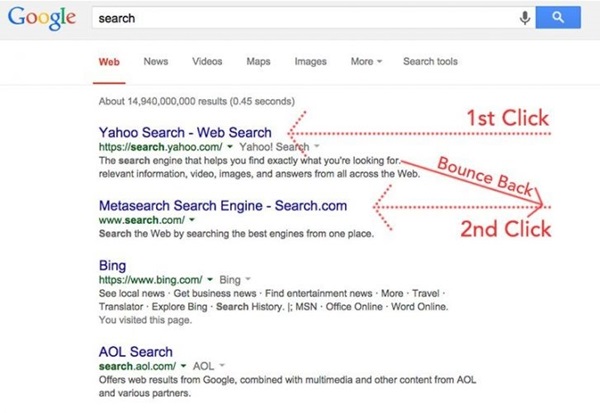Google has long been a household name—we all know how to use it, both as a search engine and as an official verb, and it’s safe to say the platform has been standardized into our daily lives. But how exactly does Google work? What makes Google rank websites in the order that they’re in? These are some of the questions on every digital marketer’s mind. Of course there are the ranking factors we’re all aware of, such as optimized meta data, quality content, and inbound links. But what else might affect ranking? There are factors such as click throughs to a site, the amount of time spent on the site, and leaving the site, all crucial to a user’s experience. But at the end of the day, do they impact ranking on Search Engine Result Pages (SERPs)? This article will take a deeper look into why we feel these user engagement signals do, in fact, matter in the eyes of Google.
What is CTR, time on site, and pogo sticking?
Click-through rate (CTR) is the quantitative calculation of how often a user clicks on a result in the SERP. As digital marketers, CTR is important because it gives us an understanding of how well a site is performing in search. We can analyze which pages on our site have a poor CTR, and can then optimize these pages for search intent and user expectations. We can also look at the pages with a high CTR to understand why these pages succeed, and can then apply a similar practice to other pages.
Time on site is the duration a user spends on a site after clicking through from the SERP. It provides an indication of how well users interact with the site. We can analyze the pages where users spend a minimal amount of time, allowing us to improve the content of those pages. Time on site can also help us understand if a user has fully accomplished a particular goal. For example, if our goal is to have a user watch a 15-minute video on a page, they would need to be on that particular page for at least 15 minutes to accomplish it. If the user meets this goal, we can interpret that the contents of the video and page are relevant, engaging, and ultimately, meets the user’s intentions.
Pogo sticking is the instance in which a user clicks through from the SERP to a specific page, but then quickly returns back to the SERP to click on a different site instead. Pogo sticking helps explain if the content on our site satisfies the user’s intent or not, and if our site is optimized to show the most relevant content in a search query.

These three factors are important insights from a business standpoint, and, though unofficial, are instrumental metrics in the Google algorithm.
Is user engagement a ranking factor in Google SERPs?
Although Google has denied that they use user engagement as direct ranking signals in their algorithm, many authoritative leaders in the SEO industry have experimented with testing these factors, and collected telling results. Moz founder Rand Fishkin set up one such experiment, posting a Tweet for users to click through to his blog post that was ranking No.7 on Google’s SERP. Google reported that Rand’s post had received 228 visits the day he posted the Tweet—moving it from No.7 to No.1 on the SERP within three hours. Similarly, SEO expert and Backlinko founder Brian Dean also tested user engagement as a ranking signal. Through an analysis of 100,000 websites, he discovered that there was, indeed, a correlation between low bounce rates and higher rankings.
As you can see, the data from these experiments seem to support the opinion that user engagement does affect ranking, at least to some degree. The truth is, we may never really know how these signals are interpreted unless Google eventually fesses up. But also consider this: whether or not click-through rate, time on site, and pogo sticking are direct signals to climb the rankings, they are significant metrics that we should always be improving upon. By analyzing these factors, we can assess where we are successful with meeting the user’s intent, and where we can make adjustments. User engagement, retention, and keyword relevance demonstrate to Google that the user is satisfied with their search result and experience, and at the end of the day, that’s all that really matters.
